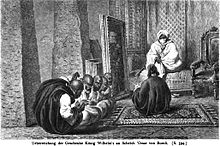Umar of Borno
| Umar of Borno | |
|---|---|
 "Umar von Bornu" on 6 June 1870 by Gustav Nachtigal in his travel's narrative, Sahara und Sudan, p.594 | |
| Reign | 4 June 1837 - December 1881 |
| Predecessor | Muhammad al-Amin al-Kanemi, Kanemi |
| Successor | Bukar Kura |
| Died | December 1881 Borno |
| Burial | |
| Issue | Bukar Kura |
| Dynasty | Kanemi |
| Father | Muhammad al-Amin al-Kanemi |
| Religion | Muslim |
Umar I ibn Muhammad al-Amin (Arabic: اولعمر ابن محمد لرشيد) or Umar of Borno (died 1881) was Shehu (Sheik) of the Kanem-Bornu Empire and son of Muhammad al-Amin al-Kanemi.
Reign of Umar[]
Umar came to power at the death of his father in 1837.[1][2] Umar did not match his father's vitality and gradually allowed the kingdom to be ruled by advisers (wazirs). Umar ruled from 1837 until November 1853 when he was deposed by his brother `Abd ar-Rahman ibn Muhammad al-Amin who became Shehu. The latter only reigned until 1854 when Umar reconquered his throne.[3]
Umar ruled as Shehu for a second time from September 1854 to 1880. Borno began to decline, as a result of administrative disorganization, regional particularism, and attacks by the militant Ouaddai Empire to the east. The decline continued under Umar's sons, and in 1894 Rabih az-Zubayr, leading an invading army from eastern Sudan, conquered Borno.[4]
Dynasty[]
Footnotes[]
- ^ Louis Brenner, The Shehus of Kukawa: A History of the Al-Kanemi Dynasty of Bornu, Oxford Studies in African Affairs (Oxford, Clarendon Press, 1973), p.72.
- ^ Herbert Richmond Palmer, The Bornu Sahara and Sudan (London: John Murray, 1936), p. 269.
- ^ Louis Brenner, The Shehus of Kukawa: A History of the Al-Kanemi Dynasty of Bornu, Oxford Studies in African Affairs (Oxford, Clarendon Press, 1973), pp.78-79.
- ^ Helmolt, Hans F., ed. (1903). The history of the world; a survey of a man's record, Volume III: West Asia and Africa. New York: Dodd, Meade and Company. p. 538. OCLC 1193060.
Bibliography[]
- Brenner, Louis, The Shehus of Kukawa: A History of the Al-Kanemi Dynasty of Bornu, Oxford Studies in African Affairs (Oxford, Clarendon Press, 1973).
- Cohen, Ronald, The Kanuri of Bornu, Case Studies in Cultural Anthropology (New York: Holt, 1967).
- Denham, Dixon and Captain Clapperton and the Late Doctor Oudney, Narrative of Travels and Discoveries in Northern and Central Africa, (Boston: Cummings, Hilliards and Co., 1826).
- Isichei, Elizabeth, A History of African Societies to 1870 (Cambridge: Cambridge University Press, 1997), pp. 318–320, ISBN 0-521-45599-5.
- Lange, Dierk, 'The kingdoms and peoples of Chad', in General history of Africa, ed. by Djibril Tamsir Niane, IV (London: Unesco, Heinemann, 1984), pp. 238–265.
- Last, Murray, ‘Le Califat De Sokoto Et Borno’, in Histoire Generale De l'Afrique, Rev. ed. (Paris: Presence Africaine, 1986), pp. 599–646.
- Lavers, John, "The Al- Kanimiyyin Shehus: a Working Chronology" in Berichte des Sonderforschungsbereichs, 268, Bd. 2, Frankfurt a. M. 1993: 179-186.
- Oliver, Roland & Anthony Atmore (2005). Africa Since 1800, Fifth Edition. Cambridge: Cambridge University Press. ISBN 0-521-83615-8.
- Palmer, Herbert Richmond, The Bornu Sahara and Sudan (London: John Murray, 1936).
- Taher, Mohamed (1997). Encyclopedic Survey of Islamic Dynasties A Continuing Series. New Delhi: Anmol Publications PVT. LTD. ISBN 81-261-0403-1.
External links[]
- History of Nigeria
- Bornu Empire
- Royalty of Borno
- 1881 deaths
- 19th-century rulers in Africa
- Kanuri warriors
- Nigerian Muslims
- Muslim monarchs
- People from Borno State
- African royalty stubs
